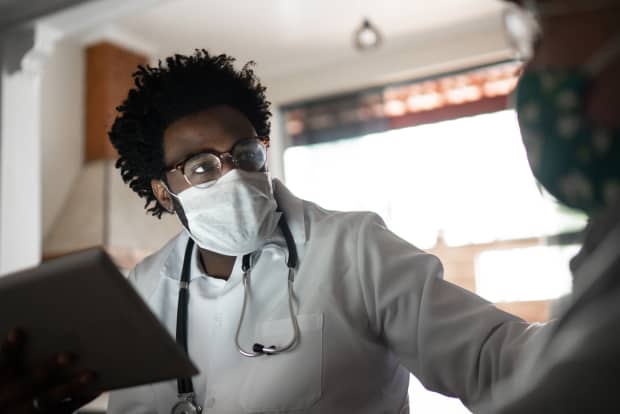
Doctor using digital tablet and talking to patient at home
iStock/FG Trade
The initial stage of the COVID-19 pandemic coincided with a “dramatic” decline in preventive and elective health-care use, according to a recent analysis of millions of insurance claims. The resulting rise in telemedicine use, meanwhile, didn’t totally make up for the reduced in-person visits — and saw disparities along income, racial and ethnic lines.
For example, use of colonoscopy — a procedure often used to screen for colon cancer — decreased by about 70% for March and April relative to rates seen in March and April of 2019, according to the study published in JAMA Network Open.
Women aged 46 to 64 had a 67% relative reduction in mammograms, low-dose X-rays used to screen for early signs of breast cancer. Hemoglobin A1C tests, which measure blood-sugar levels, were down nearly 51%. And kids aged 0 to 2 saw a 22% relative reduction in vaccines, as health-care professionals have stressed the importance of routine pediatric immunizations.
“This adds detailed evidence to the anecdotal reports that Americans quit going to see the doctor when the pandemic shutdown started,” lead study author Christopher Whaley, a policy researcher at the think tank RAND, said in a statement. “If important visits are only delayed for a few months, there will likely be no harm. But if patients do not get important screenings, there could be long-term negative health consequences.”
Angioplasty, a procedure that opens blocked arteries, was down almost 17%. Relative use of musculoskeletal surgery decreased by 47%, cataract surgery declined nearly 60%, and MRIs fell by 45%.
There was a roughly 4% relative decrease in chemotherapy treatments, the study found; use of cholesterol-lowering statins decreased by almost 3%, and use of antidiabetic drugs decreased 2%. Use of asthma medications, on the other hand, rose 11%.
“ ‘Extending care deferrals for many months, or even perhaps until a COVID-19 vaccine is developed could substantially harm patient health.’ ”
Meanwhile, telemedicine use surged during the pandemic’s first two months. But the increased use in March and April “offset only 40% and 42%, respectively, the reduction in office visits,” the authors wrote.
“[W]e found smaller reductions in care use and lower rates of telemedicine use among patients residing in zip codes with lower-income or predominately racial/ethnic minority populations,” they added. “The extent to which access barriers to telemedicine contribute to lower rates of in-person care deferral and thus increases in potential exposure to COVID-19 should be examined in future work.”
The researchers were affiliated with RAND, Castlight Health CSLT,
To be sure, the analysis did not include data from groups like Medicaid or Medicare beneficiaries or people without insurance. The researchers also didn’t look into whether care that people had delayed at the beginning of the coronavirus crisis “will be deferred until the future or avoided completely,” nor did they examine the link between social-distancing policies and health-care use reductions.
“If the reductions in care we observed are delayed by a few months and then return to previous levels, as some evidence suggests, then patient health impacts may be limited, and the short-run declines in medical spending may lead to reduced annual 2020 medical spending,” the authors wrote. “However, extending care deferrals for many months, or even perhaps until a COVID-19 vaccine is developed could substantially harm patient health.”
Other studies have found a similar decline in health-care utilization as Americans weigh the importance of preventive care against potential exposure to the coronavirus.
“ Experts have also stressed the importance of getting a flu shot this year to help avoid overburdening the health-care system with a potential ‘twindemic’ of influenza and COVID-19 hospitalizations. ”
An analysis by the Health Care Cost Institute, an independent nonprofit partly funded by four health-insurance companies that provide claims data, found that “even by the end of July 2020, utilization of many preventive services appeared to be running below 2019 levels.”
Mammograms and Pap smears fell 80% in April year over year and remained down by a respective 20% and 10% in July, that report found. Colonoscopies, which had declined nearly 90% in mid-April year over year, remained down 30% by July. But prostate-cancer screening PSA tests returned to their 2019 levels by this past June, and “use of services that cannot be deferred or forgone, like childbirth, have tracked more closely to 2019 levels.”
Patients need to get “back on track” with preventive health care, Alexander Ding, a clinical assistant professor of radiology at the University of Louisville School of Medicine, said during a recent expert panel hosted by the American Medical Association. Experts have also stressed the importance of getting a flu shot this year to help avoid overburdening the health-care system with a potential “twindemic” of influenza and COVID-19 hospitalizations.
While many preventive care services can’t be obtained without leaving home, some can, Ding said. “For example, patients who might need a colorectal cancer screening, you can actually get a consultation via telemedicine, and then you get a Cologuard EXAS,
Health-care providers must communicate to patients what they’ve done to make their facilities as safe as possible, Ding added. “I really think a health-care facility is one of the safest places you can go to right now because, I think, everyone who’s working there is taking safety so seriously,” he said.